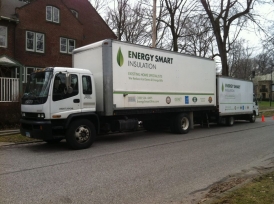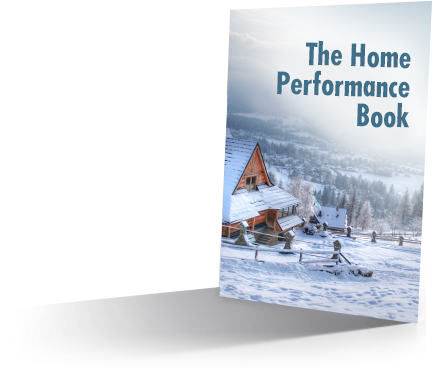Got Mold? Home Performance to the Rescue!
Do you have mold in your attic that is as fuzzy as a teddy bear? A musty, dank, nasty crawlspace that makes you sneeze when you are nearby? Do your icicles in the winter touch the ground, ripping a gutter off, leaking on the ceiling, or even making a piece of ceiling fall down? Comprehensive Home Performance can help.
Comprehensive Home Performance is the art and science of addressing flows of heat, air, and moisture in your home to solve root causes of problems. Yes, it sounds dorky. Because it is. But it also works. It can reduce or nearly eliminate many mold and moisture problems in your home. To really ‘fix’ your house, we have to get pretty good1 control over heat, air, and moisture flow.
Why do we need to control all of those? If we don’t, moisture problems like the ones described above can happen.
What Mold Needs to Grow
In the case of mold, it needs 3 things to grow:
- Food
- Temperature between 40 and 100 degrees F
- Moisture source (high levels of humidity or wet surfaces work).
The only one of those we can begin to control is moisture.
Controlling Air and Vapor – It’s Like a Leaky Boat
Air and moisture are closely related – water vapor travels on air. So if air is moving, some water is going with it, possibly a lot of water if the air is humid and the air leak is big. To stop both of these, we need to seal air leaks wherever possible. On an existing home, you aren’t likely to get all of the air leaks, but it’s like sealing up a leaky boat – when enough holes are plugged, you can bail it out faster than the water comes in.
It’s also important to concentrate on the big leaks, like a big hole at the bottom of the boat vs. a smaller hole above the waterline that doesn’t leak very often or very much. In the case of homes, air leaks at the top and bottom are most important, leaks in the walls are less important. If you can get to a tipping point of air leakage reduction and deal with the most critical leaks, you increase the odds that moisture problems from water vapor will be substantially reduced.
Controlling Liquid Water
So air sealing largely tackles water vapor getting in and out of the house, but there is still liquid water. This is where a good roof, well controlled icicles and ice dams, and a dry basement or crawlspace come in. There are lots of methods to get there that vary by the house. These are part of our evaluation.
Controlling Heat
We also need to have decent control over heat flow, which usually means insulation. If a surface is not insulated and both cold air and warm air can touch it when it’s really hot or really cold, you can get condensation when moisture laden air touches a cold surface. Do your windows get droplets on them on cold days during the winter? This is condensation. The same thing can happen inside uninsulated walls or in the attic. Or even in the summer if you cool your house to low temperatures, you may get condensation on the windows as well.
Wet surfaces with food (like paper or wood or dirt) and the right temperatures are likely to lead to mold and mildew. So it’s best if every surface is insulated and air sealed, we’ll show you plans to do that, but also less extensive plans that fit your budget.
Benefits of Controlling Heat, Air, and Moisture
When we have a fair degree of control over heat, air, and moisture, we can solve all sorts of comfort and efficiency problems, but also a lot of problems caused by moisture like mold, mildew, ice dams, damp basements and crawlspaces, and more. Your home will also be substantially more comfortable and your energy bills will go down. And those are the 4 Tenets of Home Performance – comfort, health & safety, durability, and efficiency.
Can you begin to see how all of these things are heavily interrelated? Getting to this point is not a quick fix, though. This is like a lifestyle change of diet and exercise. You can’t diet 3 days a week or pop some pills and expect great results – you have to commit.
If you’re willing to go far enough, though, moisture problems can be substantially reduced or nearly eliminated in your home. We can show you what needs to be done to solve the problem you called us for.
Caveat: There are no absolutes. Do doctors guarantee fixes? We’re not that good, either. Houses are too complex, like our bodies. We deal in likelihoods, not absolutes.
Feeling Ready to DO Something?
Curious about what it will take to reduce your ice dams, mold, musty crawlspace, and other problems? It all begins with an initial consultation where we’ll ask you a lot of questions about your home, take a look at your energy bills to see how much savings opportunity is there, and measure how much your home leaks with a blower door – air leakage is a big driver of moisture problems, comfort problems, and high energy bills. You can receive a substantial discount by filling out our questionnaire.
Click here to fill out our questionnaire and start the process.
Resources:
Moisture Control Handbook, Joe Lstiburek, 1991 – This is older, but almost all of it still holds true. Joe is probably THE preeminent expert on Building Science right now, and Building Science underpins all of what we do. You can go way down the rabbit hole with this one. It’s free, too, which is a nice bonus.
Water in Buildings by Bill Rose – An expensive book, to be sure, but it is thought to be one of the best of it’s kind. It was the first book Allison Bailes recommended to Nate.
Other Helpful Links:
1What is pretty good? It varies on every house, so we provide multiple options, and if a simpler option doesn’t work, we have a plan for what to do next.










